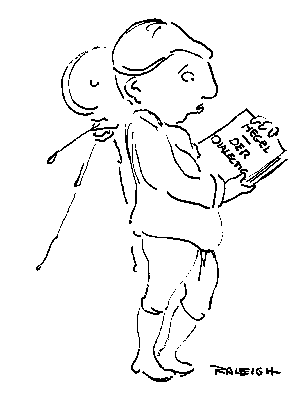 |
What Does Film Tell US?
By
HENRY P. RALEIGH
ART TIMES May 2009
Thinking about this a German Philosopher once figured that each stage in social evolution found a medium that best suited its expressive needs — sculpture had its heyday, painting had a good run, next up was architecture, but I think he missed the boat on that one. Film wasn’t around in his time; if it had been I’m sure he would have added it to the progression despite claims film wasn’t a genuine art. You see, for a long time film was considered little more than a cheap trick. A few in the beginning thought it might be an art if anyone could make the sound and the pictures match up and avoid unnerving tendency of early film to explode into flame. Still, there pioneers were largely laughed at and nothing really got done until in 1927 when the Academy of Motion Picture Arts and Sciences was founded. It was clear then that anything with the words ‘arts’ and ‘sciences’ (note the plurals) in its title was serious stuff, all right, and when the Academy began awarding Oscars for the best picture, films became officially an art bearing all the responsibility for cultural expression that bestows. Later, in 1965, another bunch of learned film lovers formed the American Film Institute which took on the task of rummaging through a hundred years of American films, over 40,000 mind you, to identify those that are the greatest of all the film arts. You can bet there’s a lot of cultural expression lurking there.
I’m sure you’re asking at this point, “OK, so what’s being expressed, wise guy?” For that answer, rather a clue to the answer (look, any discussion about ‘expression’ can be pretty hairy, even for the best of us). So with nothing else to do I decided it would be worth a shot to look over what Oscar and AFI have been up to. Surely we can come to some insights into how the newest of the arts is handling our thirst for expression.
The first problem we run into is that best picture Oscars and the top twenty-five of AFI’s picks rarely agree. I don’t know if the people in both camps argue a good deal when the selections are made or just ignore each other in a pet. It does seem strange though so let’s stick with the handful of films they do agree on, namely: “One Flew Over the Cuckoo’s Nest”, “All About Eve”, “Bridge on the River Kwai”, “Casablanca”, “Gone With the Wind”, and “Schindler’s List”. Now where does this leave us? — five war films, a film about a nut house, one on nasty business in the theater, another on even nastier business in labor unions, and one on organized crime. Is this random spread of subjects what we are all about; what does this mean, you ask? Well, you just have to find what is in common to these films, deconstruct a bit, I always say, and see what comes up. And, I’m sorry to say it isn’t very comforting as anyone can quickly tell. Perhaps a different approach to the expression issue would be more helpful. Isn’t it possible that the expressive function of film is to reveal how we grow as a society, expressing us not in the topics but in the natural evolution towards newer states of being?
Let us limit ourselves in this engaging study to just one segment of out culture and follow how film has traced out the changes that have taken place over a period of time right up to the present. As a father who has survived five teenage years, and my own was none too pretty, I can tell you, there is a slice of our society I do know something about. Up until the 1930’s there actually weren’t any films bout teenagers. Either they hadn’t been invented yet or nobody noticed they were around. Towards the end of the decade they quite suddenly appeared in film. They were, for the most part, small adults who sang and danced and said ‘Golly’ and ‘Gee Whiz’ and we could be proud of them. The Dead End Kids were an exception but they were isolated social cases and, in any event, they never cursed. A startling change occurred in the filmic expression of teens with “Blackboard Jungle” and “Rebel Without a Cause”, both in 1995. Annette Funicello and Sandra Dee and a swarm of Beach films tried hard to thwart this direction and failed. Film expressions of the teen evolution was unstoppable and has wound up in our time with such seminal works as “Porky’s”, “Superbad”, Juno”, “Pineapple Express” culminating in my estimation, with the recent 2008 avant-garde “The Nottie and the Hottie” starring the iconic Paris Hilton, a film that Oscar and AFI will pay serious consideration. Here is expressed the full maturity of the teenage culture, its influence and shaping of our society. The difference between teens and adults is indistinguishable, we see in this film that the two have melded splendidly and points the way, I venture to say, to the next phase of our social development — a uniform level of mentality that no twelve year old need feel inferior to. And this, you see, is the expressive role of the artistic avant-garde, to show us what our future is to be.
Well, I think we’ve learned something about the subtle ways that film art gives expression to what we are. That may be disappointing, I know, but to support our conclusions let me leave you with this quote in EW from a major film distributor commenting on the box office hits of this past year: “America is still depressed, which is why comedies and superhero movies do so well.” And you can see why, too. As the poet said, we get what we deserve.
